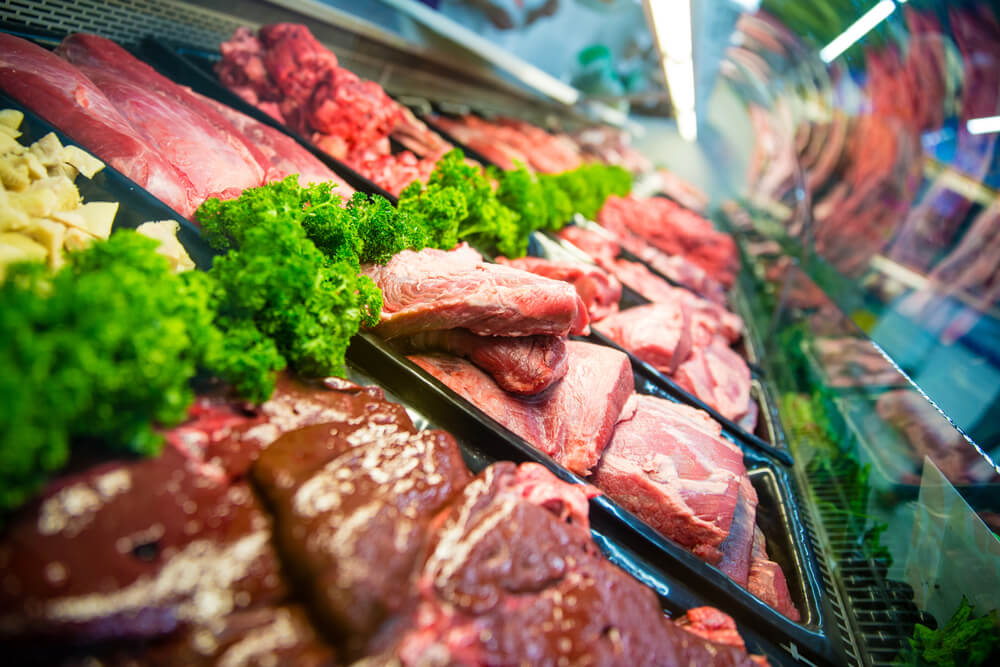Cost of Beef in a Super Market
 Fact Checked
Fact Checked
It'south no secret that trimming the fat on your grocery neb goes a long way to beef up your savings. While meat can make up a large chunk of your supermarket spend, you don't need to fork out big bucks to get some pork on your fork.
Beneath, nosotros reveal how much Aussies spend on meat at the supermarket per week for comparison. We also provide a guide that includes the average spend on meat by land, household size, income, historic period group, and supermarket, plus listed some budgeting tips.
How much do Aussies spend on meat each calendar week?
Aussie households spend on average $41 per week on meat (including seafood) at the supermarket, according to a Canstar Bluish survey of supermarket shoppers*. This equates to well-nigh $164 a month or $i,968 a year. The price of meat and seafood products per week makes up virtually a quarter of the average weekly grocery spend in Australia − $153.
Here are some other meaty facts about meat preferences, every bit found in our survey:
- Over a quarter of Aussies (26%) eat meat every day, while roughly the same number (24%) have considered eating less meat for wellness or ecology reasons
- 27% try to purchase ethically sourced meat (i.e. free-range chicken, grass-fed beef, etc.)
- Over a third of Aussies (37%) would eat more seafood or fish if it was less expensive
- Some other 27% of people prefer to purchase meat from a supermarket rather than a butcher

Which supermarket is the cheapest for meat?
This table displays the average weekly meat spend past supermarket, based on a Canstar Blue survey of more than 6,000 Australian shoppers.
| Supermarket | Average weekly spend on meat |
| Woolworths | $43 |
| Coles | $44 |
| ALDI | $46 |
Source: Canstar Blue research, December 2021.
Our survey institute that Aussies who shop at Woolworths tend to spend less on meat per week than those who shop at Coles and ALDI. This may suggest that shoppers are willing to spend more on quality meat products in budget supermarkets where they can save money on other essentials. Just keep in heed that Australian meat retail costs will vary between supermarkets, based on factors like supply and demand, production costs (i.due east price of grain, etc.), seasonality, and benefactor pricing (what a supermarket pays to source and stock a particular product).
What's the cheapest type of meat?
Aussie shoppers tend to spend less on chicken than on any other type of meat − $14 per week − while people spend about $25 per week on lamb, according to our survey.
- The average spend for seafood and beef was $23 per week
- The weekly spend to become pork on your fork was $xx
Boilerplate meat spend by state
This table shows the boilerplate weekly spend on supermarket meat and seafood products across Australian states, based on a Canstar Blueish survey of more than half dozen,000 shoppers.
| State | Average weekly spend on meat |
| Tasmania | $36 |
| Victoria | $38 |
| Western Australia | $39 |
| South Commonwealth of australia | $40 |
| Queensland | $43 |
| New S Wales | $43 |
Source: Canstar Blueish research, December 2021.
As outlined to a higher place, households in Tasmania reported the lowest boilerplate spend on meat weekly, while Aussies in Queensland and New Due south Wales spend the most on meat per calendar week, to the tune of $43 per calendar week ($seven more than).
Average meat spend in TAS
People in Tasmania pay on average $36 per week for meat at the supermarket – the least of all states. This equates to $144 a month or $one,728 per year. This is perhaps due to the fact that merely 21% of households in Tassie consume meat every twenty-four hour period, compared to other states where more people swallow meat daily. Our survey also found that 15% of Tasmanians have watched media (i.e. videos, documentaries, etc.) that has made them more conscious of ownership ethically-sourced meat and seafood (i.e. organic, grass-fed, wild-defenseless, etc.).

Boilerplate meat spend in VIC
Households in Victoria recorded the 2nd-lowest average spend on meat per week − $38. This adds up to near $152 a month or $1,824 per yr. Our latest survey constitute that nearly half of Victorians (47%) effort to purchase the freshest meat available (i.e. with a later expiration date), while 13% likewise prefer to purchase meat from the cafeteria section of their supermarket, rather than pre-packaged meat from the fridge section.
Average meat spend in WA
Shoppers in Western Australia pay on boilerplate $39 per week for meat at the supermarket. This equates to $156 a month or $one,872 per year. Our survey establish that 63% of Western Australians buy meat on their regular grocery shop (63%), more than in whatever other state. A tenth (10%) would also consider eating lab-grown meat, more than in whatever other state.
Average meat spend in SA
Households in South Australia fork out on average $xl per week on meat and seafood products, equalling $160 a calendar month or $one,920 per year. Our survey found that about a tertiary of shoppers in SA (29%) opt to buy meat from a supermarket rather than a butcher, and a similar portion (28%) also buy marinated meat from the supermarket.

Average meat spend in QLD
People in Queensland spend on average $43 per week on meat at the supermarket − the most of all states (on par with NSW). This equates to $172 a month or $2,064 per year. A quarter of shoppers in the Sunshine State (29%) tend to buy meat in majority (i.eastward. to freeze, etc.), while 26% are also willing to pay more for ethically sourced meat or seafood.
Average meat spend in NSW
In New South Wales, people also pay on boilerplate $43 per week for meat and seafood at the supermarket, equating to $172 a month or $2,064 per year (on par with QLD). Our latest survey suggests that shoppers in NSW seem to be more health and eco-conscious, with 26% having considered eating less meat for health or ecology reasons.
Average meat spend by household size
This table shows the average weekly spend on meat and seafood products in Australia past household size.
| Household size | Average weekly spend on meat |
| 1 | $twoscore |
| 2 | $53 |
| 3 | $57 |
| 4 | $75 |
| 5 or more | $46 |
Source: Canstar Blue research, December 2021.
Naturally, households with more people (including dependents) spend more on meat per week – near $35 more – than unmarried-person households. Every bit a dominion of thumb, nutrient expenditure generally goes upwards by $40-l with every person in a household.
Average meat spend by age group
People who may accept more dependants at accuse like millennials and people aged under 30, tend to spend a petty more than on meat at the supermarket each week than older Australians (under 60 years of age) who spend the least. Here's a breakdown of the average weekly meat spend by historic period grouping, based on our latest survey results.
| Age grouping | Average weekly spend on meat |
| 18 to 29 years | $42 |
| 30 to 39 years | $41 |
| 40 to 49 years | $41 |
| 50 to 59 years | $39 |
| sixty to 69 years | $41 |
| 70 years and over | $40 |
Source: Canstar Blue research, December 2021.

Average meat spend by household income
Loftier-income households tend to spend a fraction more than on meat per week – about $12 extra than low-income earners. Hither's an overview of the average weekly spend on supermarket meat and seafood products by household income.
| Household income | Average weekly spend on meat |
| Less than $xxx,000 | $33 |
| $30,000 to $49,999 | $39 |
| $50,000 to $79,999 | $42 |
| $80,000 to $119,999 | $43 |
| More than $120,000 | $45 |
Source: Canstar Blue research, December 2021.
Yous may as well be interested in:
- Online Groceries
- Supermarket Ratings
- Supermarket Meats
- Supermarket Bakeries
Top v tips to save money on meat at the supermarket
- Shop meat at the end of the day: Supermarkets typically disbelieve meat products nearing their used-by date at the finish of each solar day to make fashion for fresher stock the following twenty-four hours. This means that shopping in the afternoon around 4pm or 5pm could salvage you large dollars on a rump steak or seafood! Keep your eye out for 'reduced' stickers.
- Try a meat-gratis meal once a calendar week: Going meatless one solar day per week could save you most $40 a month and make family dinners healthier by substituting animal products with veggies and plant-based alternatives like tofu and lentils. Win-win.
- Buy meat in bulk: You can oftentimes purse a bargain past buying meat in bulk when it's on sale and freezing the lot for subsequently. You lot can also attempt buying meat in bulk from a wholesaler or butcher.
- Purchase cheap cuts of meat: Buying cheap meat cuts similar chuck steak and chicken drumsticks could not only save you loads of money in the long run merely also help you whip up fancy dishes like Beefiness Bourguignon and Coq Au Vin to impress the family. Oui!
- Compare prices: Check out the price per kilogram of your favourite meat cuts and seafood and compare prices from different supermarkets and butcher shops. Keep in mind that supermarkets typically release their weekly specials on Wednesdays.
Compare Supermarket Meats
*Survey based on shoppers who have purchased and eaten a supermarket homebrand meat product (i.e. steak, mince, cutlets, etc.) from a supermarket in a 4-week period – in this case, 6,010 people.
Source: https://www.canstarblue.com.au/groceries/average-meat-cost/
Post a Comment for "Cost of Beef in a Super Market"